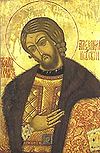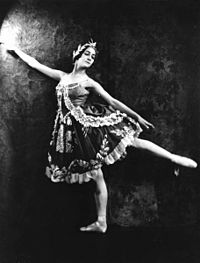- Olga Spessivtseva
-
Olga Alexandrovna Spessivtseva [1] (18 July [O.S. 6 July] 1895 – 16 September 1991) was a Russian ballerina whose brilliant stage career spanned from 1913 to 1939. She was one of the outstanding classical ballerinas of the 20th century.
Biography
Olga Spessivtseva was born in Rostov-on-Don, the daughter of an opera singer. After her father's death, she was sent to an orphanage in St. Petersburg with theatrical connections. She entered St. Petersburg's Imperial Ballet Academy in 1906, where she was a student of Klavdia Kulichevskaya and later of Yevgenia Sokolova and Agrippina Vaganova. After graduating in 1913, she joined the Mariinsky Theatre, where she was promoted to soloist in 1916. An exquisite romantic dancer with perfect technique, ideally suited for roles such as Giselle and Odette-Odile in Swan Lake, she quickly became one of the most admired dancers in the company. In later years George Balanchine, then a student at the Imperial Ballet school, remembered her dancing with awe and admiration.
In 1916, Sergei Diaghilev invited her to tour with the Ballets Russes in the United States, where she danced with Nijinsky in Le Spectre de la Rose, Les Sylphides and the Bluebird pas de deux from The Sleeping Beauty. In 1918 she returned to the Mariinsky, renamed the Petrograd Opera and Ballet Theater, and was promoted to ballerina. At this time she was almost unknown in the West. She continued to perform with the Ballets Russes abroad, dancing Aurora in Diaghilev's renowned The Sleeping Princess in London in 1921, and at the Teatro Colón in Buenos Aires in 1923. With the aid of her ex-husband Boris Kaplun, a Bolshevik functionary and lover of the arts, she left Russia for the last time in 1924, accepting an invitation to dance as an étoile (prima ballerina) at the Paris Opera Ballet, where she remained until 1932. During that time, she maintained her relationship with the Ballets Russes. In 1932 she made another historic guest appearance in London, dancing Giselle with Anton Dolin. From 1932 to 1937 she toured with a number of companies throughout the world, performing roles from both the classical repertoire and contemporary ballets by choreographers such as Michel Fokine and Bronislava Nijinska. When dancing abroad, she was frequently billed as Olga Spessiva.
Spessivtseva had experienced periods of depression as early as 1934, showing signs of mental illness in Sydney and needing hospitalisation. In 1937 she left the stage due to a nervous breakdown. She did some teaching, then briefly returned to performing, making her farewell appearance at the Teatro Colón in 1939. That same year, she moved to the United States where she taught and served as an advisor to the Ballet Theatre Foundation. She suffered another nervous breakdown in 1943, for which she was hospitalized. She remained institutionalized until 1963 when, with the help of her friends Anton Dolin, Felia Doubrovska and Dale Fern, she was discharged and settled in Valley Cottage on the Tolstoy Farm, a Russian community run by the Tolstoy Foundation in New York's Rockland County, which had been founded by Countess Alexandra Tolstaya, daughter of the novelist, as a rest home for Russians. Recovered, she lived there in peaceful retirement for nearly three decades, dying at the age of 96.
In London in 1921, Diaghilev revived The Sleeping Beauty with Spessivtseva as the Princess Aurora. Anton Dolin, who was a boy of 16 at that time, danced in the ensemble. He later described the effect achieved by the shy ballerina when she reported for practice at Maestro Cecchetti's Academy, "No sooner had she started her exercises at the barre than they all realised they were in the presence of genius. When they were called up in groups of four to do the adagio exercises, the three others in line with Spessivtseva fell back one by one and left her dancing alone".[citation needed]
The BBC put out a short programme about her life in 1964, and two years later Anton Dolin wrote a book about her. The title of both was 'The Sleeping Ballerina'. Expert dance writers have described her as "the greatest of Russian ballerine at this period",[2] and "The supreme classical ballerina of the century".[3]
In 1998, Russian choreographer Boris Eifman made her the heroine of his ballet Red Giselle. Today, she is remembered as one of the greatest classical dancers of all time.
References
- ^ also transliterated as Spesivtseva, Spessivtzeva, Spessiva) (Russian: Ольга Александровна Спесивцева
- ^ Beaumont, Cyril 1940. The Diaghilev Ballet in London. Written of her engagement for the premiere of the Sleeping Princess in 1921. p193
- ^ Clarke, Mary and Crisp, Clement 1981. The history of the dance. Orbit, London. p174
- Craine, Debra and Mackrell, Judith (2000). The Oxford Dictionary of Dance. New York: Oxford University Press. ISBN 0-19-860106-9.
- Dolin, Anton (1966). The Sleeping Ballerina: The Story of Olga Spessivtzeva, with foreword by Dame Marie Rambert. Muller, London.
- The Great History of Russian Ballet: Its Art and Choreography (1998). Bournemouth, England: Parkstone Publisher; The Great Encyclopedia of Russia Publishing House. ISBN 1-85995-175-9.
- Kahane, Martine [text] and Wild, Nicole [illustrations] (1992). Les Ballets Russes à l’Opéra. Paris: Editions Hazan, Bibliothèque Nationale. ISBN 2-850-25-249-2.
- Koegler, Horst (1982). The Concise Oxford Dictionary of Ballet. Second Edition. New York: Oxford University Press. ISBN 0-19-311330-9.
- LeMoal, Philippe (1999). Larousse Dictionnaire de la Danse. Paris: Larousse, Librairie de la Danse. ISBN 2-03-511318-0.
- Lifar, Serge (1957). Les trois graces du XX° siècle—Légends et vérités. Paris: Corréa-Buchet Chastel.
- Lifar, Serge (1959). The Three Graces: Anna Pavlova, Tamara Karsavina, Olga Spessivtzeva: The Legends and the Truth. Translated by Gerard Hopkins. London: Cassell & Co.
- Kennedy, Ludovic (1959). The Sleeping Ballerina BBC. Television documentary, including archival footage.
- The Daily Telegraph - Third Book of Obituaries (Entertainers). Edited by Hugh Massingberd
External links
- A postcard of Olga Spessivtzeva, circa 1920, striking a dance pose, as depicted on a poster by Boris Lipnitzki
- Russian page describing Kaplun's help in her emigration
- Olga Spessivtseva at Find a Grave
People from Russia Leaders and religious - Pre-1168
- 1168–1917
- 1922–1991
- 1991–present
- RSFSR leaders
- General secretaries
- Soviet premiers (1st deputies)
- Soviet heads of state (and their spouses)
- Prime ministers (1st deputies)
- Foreign ministers
- Prosecutors general
- Metropolitans and patriarchs
- Saints

Military and explorers - Field marshals
- Soviet marshals
- Admirals
- Aviators
- Cosmonauts
Scientists and inventors - Aerospace engineers
- Astronomers and astrophysicists
- Biologists
- Chemists
- Earth scientists
- Electrical engineers
- IT developers
- Linguists and philologists
- Mathematicians
- Naval engineers
- Physicians and psychologists
- Physicists
- Weaponry makers
Artists and writers Sportspeople - Chess players
Categories:- 1895 births
- People from Rostov-on-Don
- Prima ballerinas
- Russian ballet dancers
- Russian expatriates
- People from Rockland County, New York
- 1991 deaths
Wikimedia Foundation. 2010.


